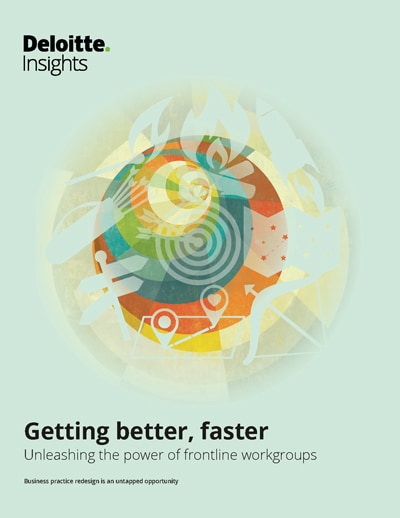Eliminate unproductive friction has been saved

Eliminate unproductive friction Seek ways to make friction as productive as possible
31 January 2018
 John Hagel III United States
John Hagel III United States John Seely Brown (JSB) United States
John Seely Brown (JSB) United States Andrew de Maar United States
Andrew de Maar United States Maggie Wooll United States
Maggie Wooll United States
A workgroup may not get much done without friction, but too many disagreements can derail everything—who wants to spend every meeting arguing? Minimizing and managing unproductive friction, then, is key to building trust and working toward encouraging member discussions that can generate better solutions.
Teams that bring these diverse styles together should, in theory, enjoy the many benefits of cognitive diversity, ranging from increased creativity and innovation to improved decision-making. Yet time and again, diverse teams fail to thrive.—Suzanne M. Johnson Vickberg and Kim Christfort1
Introduction: How much is too much?
When diverse people with different ideas come together, friction is inevitable—and can be highly generative. When workgroup leaders are able to channel that friction into challenging and strengthening the group’s thinking, new approaches can emerge. For workgroups that need to constantly develop better solutions in order to accelerate performance, the more diverse the flows coming together—the more friction—the better. The point isn’t just to bring in more ideas but to create something new and better when—not if—the knowledge, ideas, data, and resources conflict.
Learn More
Explore the practices and case studies
Read an overview of the opportunity
Download the full report or create a custom PDF
That is productive friction. Group members bring their diverse perspectives to challenge each other’s thinking, and such challenges can expose inadequacies in the approach and uncover gaps in understanding. They can also broaden the possibilities and point a workgroup to explore new, more fruitful directions. Indeed, a virtuous cycle can develop: When we see friction leading to better results, we may be more willing to bring challenges and divergent views to the table, expanding the flows.
But there’s a limit: Too much friction, or friction of the wrong kind, can flatten flows and derail a workgroup. With tensions festering, a group might lose energy and lack the time or energy to seek out the flows that might have the highest impact. A group may not risk interrupting progress to question its assumptions or approach. Members can become less willing to challenge their own beliefs, show weakness, or expose themselves to criticism, and less willing to push boundaries and take risks as a group.
Whether a workgroup has been in existence for a while or is just forming, in most organizations members don’t likely share an overabundance of trust. When unproductive friction goes unmanaged, a group doesn’t work to create better approaches, and performance may slip. Members can become frustrated, further losing trust in the workgroup; they may withdraw either formally or by increasingly declining to express divergent ideas or challenge other members. Minimizing and managing unproductive friction is key to building trust and encouraging members to put forward more of the types of friction that can generate better solutions.
You know you need this practice when:
- People seem frustrated or unhappy
- People feel put down upon, dismissed, or rejected
- Some voices are not being heard
- Hierarchy is preventing people from being forthright
- We spend most of our time talking about what we agree on versus what we don’t
- Our best talent doesn’t stick around for very long
The eliminate unproductive friction practice: What it is
This practice is about fostering trust and creating an environment that encourages more productive friction while minimizing the types of friction that might make workgroup members hesitant to challenge and interact.
Productive friction can help a workgroup actively create new knowledge. It can arise from engaging diverse individuals around an outcome about which they are passionate and playing with the resulting tension—if the individuals are willing and able to challenge and build on each other’s perspectives. That typically means the friction is focused around the what or the how instead of on individuals.
Unproductive friction is often rooted in members feeling threatened, misunderstood, or disrespected, which can escalate conflicts and harden positions such that a group reaches poor compromises and continually sub-optimizes. Unproductive friction can be caused by, among other things, miscommunication, interpersonal conflict, competition for resources, political behavior, status-seeking, zero-sum mind-sets, a culture of blame, or different personalities and styles. Friction can also become unproductive when it occurs at the wrong time or place.
Creating friction and eliminating the unproductive elements of that friction is a balancing act. It’s often challenging to get the balance right, and perhaps understandably, many organizations have aimed to reduce friction in the first place. After all, no one is penalized for insights not surfaced—they aren’t visible. But friction is visible, often in a negative way. Avoiding conflict is always the easier path.
Eliminating unproductive friction balances:
- Preventing certain types of unproductive friction from occurring. Build trust, and focus on the learning opportunity and the group’s larger goals. A sufficiently meaningful and urgent outcome, such as the life-or-death nature of firefighting, tends to minimize unproductive friction.
- Making friction more productive. This might include leading with questions rather than making pronouncements—for example, instead of, “That won’t work—we already tried it,” asking, “What has changed that makes us believe this could work?”
. . . and what it isn’t
Being more efficient. After decades of scalable efficiency, there’s often an underlying assumption that friction is always unproductive and undesirable. Friction can definitely slow things down, at least in the short term. But accelerating learning in order to achieve greater impact isn’t simply executing against a plan.
Eliminating all friction/fitting in. Much of the focus on group dynamics tends to be on minimizing differences and focusing on common ground. We often lack confidence in our ability to manage friction and, naturally, look to get along with everyone, especially as the workplace itself becomes more diverse. As a result, the bias is to assemble like-minded teams and favor fit, though “team players” often go along to get along rather than provoking a group to improve itself.
Removing emotions and feeling. Emotion and feeling play a vital role as a source of understanding and motivation as well as of friction. When people are passionate about an outcome, they bring emotion. Creating space for feelings can help to foster the relationships that workgroup members may need to work productively through friction.
Safety from discomfort. At the same time, this practice isn’t about creating a safe space where group members won’t be challenged on their beliefs, assumptions, and ideas. Challenges should be respectful and with the intent of arriving at a better understanding, rather than to be divisive, but this doesn’t mean that people uncomfortable with rigorous discussions should expect to avoid them altogether.
Putting the practice into play
Workgroups can make friction more productive and subvert the unproductive aspects by fostering trust and respect and having learning conversations. The two reinforce each other: trust is a prerequisite for learning, and as learning happens, trust and respect deepen. At the same time, you can’t really have trust, or learning, until you have friction. In disagreement, conflict, or crisis, you get to see how people behave. These moments can also reveal the hidden depths and strengths of a community.
Foster trust and respect
Our notion of trust has changed. An organization’s success used to come from owning some knowledge or formula that no one else knew, applying those knowledge stocks in distinctive but repeatable ways, and doing it efficiently. Trust was grounded in having the specific skills and knowledge necessary to deliver the expected results. The leader had to trust that subordinates would execute his plan, efficiently and without challenging it; the workers had to trust that the leader’s plan would be effective, with minimal changes or need for rework. Strength and certainty reigned.
Trust based on knowledge stocks, predictability, and efficiency is no longer as compelling. In fact, when the goal is to achieve more impact than the sum of the workgroup’s parts, trying to establish trust in this way can actually erode it. While past actions or accomplishments suggest how we can expect someone to act in the future, trust is becoming more about whether we believe a person has the disposition and values to learn and work together even if his existing skills are being challenged or made obsolete. Any person, whether a leader or a peer, claiming to know all the answers rings false when we see the environment changing rapidly and know ourselves to be increasingly in unfamiliar situations. Instead, the type of trust that workgroups may need comes in part from attributes that used to be considered weaknesses.
Expressing vulnerability and encouraging humility can establish a trust that isn’t premised on power, control, or omniscience. At the workgroup level, this might start with collectively acknowledging a situation’s realities and difficulties. When a workgroup makes a practice of establishing what we don’t know, what else don’t we know?, and this is what we need help with, it makes space for individuals to be open about needing help or having gaps in understanding or ability. Other group members would trust more, and be likely to admit their own vulnerability, further deepening trust. Asking for help can give others a mechanism to step forward to help fill the gaps—and is what can make vulnerability powerful.
It isn’t just OK to admit weakness—for this type of trust, it is essential. This is important: When members don’t conceal deficiencies and don’t delay asking for help, the group can learn more rapidly and uncover valuable new resources. Of course, being vulnerable should be a prelude to discussion, not an ending—no one wants a group member who regularly throws up his hands and says, “I need help!” without an inclination to dig in and work together to figure it out. The practice is to become more aware of what we lack and more effectively frame our needs to elicit better help.
Trust and respect together can provide the basis for being open to new information, listening deeply and working to understand divergent ideas, and being willing to accommodate contradictions and embrace discomfort.
Group norms that can reinforce respect can emerge through the way the group discusses and frames the challenge. Start with the expectation that members will treat each other with courtesy and an assumption that everyone has value to offer. Build a respectful climate by letting people with conflicting positions explain their reasoning—within time constraints—rather than quickly jumping to “agreeing to disagree.” This can be the time for group members to practice challenging ideas rather than people and begin to demonstrate that they can engage with others’ observations without either sugarcoating or overreacting. Groups may have to be more deliberate to guard against the subtle reactions that communicate that honesty and interpersonal risk-taking hinder a workgroup’s forward progress.
Even in a group where members appear predisposed to extend courtesy to each other, disagreements and misunderstandings often arise. Being able to empathize with other members—and to recognize that disagreements might arise from unmet, unarticulated needs rather than from bad intentions or incompetence—can reduce the negative friction. Try to meet in person, at least at the beginning, and discuss different working styles, preferences, and strengths. A framework, such as Deloitte’s Business Chemistry (see figure 1), can provide structure for understanding and discussing differences that lead to unmet needs and can set the tone for embracing the differences that cause friction.2

Making it about we, not me can help keep the workgroup focused on a shared outcome and members’ mutual commitment to it rather than on their individual identities, fears, and ambitions. Language can matter in subtly shifting the group; avoid assigning ownership to specific ideas or questions and actively guide the discussion away from who is right and toward what is right. Of course, even in a workgroup that celebrates group successes and shares rewards and recognition, some individuals might not be able to shake the me-first mentality. The Royal Caribbean Cruises Ltd. Newbuild & Innovation workgroup, which includes external designers and other specialists, learned that no matter how talented a member was, the group would benefit only if she was committed to the shared outcome and open to being challenged. Now everyone, including designers with brand recognition, presents to the entire workgroup to reinforce that all decisions are about the shared outcome and all members have an investment in those decisions. Designers might ask questions of the architects; restaurateurs might challenge the designers—and outsiders really like working with RCL because they are able to learn so much more through this practice.3
While deep trust and respect often take time to develop, there are tactics that can help build deep trust swiftly. As a workgroup:
Assume trust. Extend trust (and respect) to all members from the outset, assuming best intentions and value to offer, and establish that everyone is committed to achieving a shared outcome.
Invite trustworthiness. Find near-term tasks to give individuals opportunities to act in ways that are transparent and show commitment to the workgroup and openness to learning.4 This can be as simple as demonstrating, in less significant matters, that they are willing to voice their views, to take actions that are consistent with what they voice, and to have their views challenged and changed.
Work together to deepen trust. Deeper trust and respect ultimately come from observing others in action. When members actively work together on a shared outcome, they begin to act as a community of practice, bound together through “shared experience, reciprocal trust, and a collective world view.”5 Working side by side, trust and respect deepen as group members see each other live their values and gain deeper appreciation for what individuals have to offer.
Research has shown that workgroups identify more strongly as a group and show higher levels of innovation when their members share certain non-negotiable work values.6 These might include core tenants that guide how the group pursues the outcome, such as treating each other with respect, maintaining personal integrity, and acting legally and ethically, as well as some that might be workgroup-specific, such as acting sustainably or supporting members’ personal goals.
Intersections with the other eight practices:
- Maximize the potential for friction: Eliminating unproductive friction can help clear the way for the group to benefit from bringing diverse perspectives and cognitive styles to bear on an issue. Managing disagreements and tensions effectively can help members be more receptive to bringing in an even greater diversity of voices and resources.
- Cultivate friction. The more productive the friction becomes, and the more the group trusts that destructive friction will be handled effectively, the more members will likely also be open to challenging, creating a virtuous cycle.
- Commit to a shared outcome. Group members trust each other to act in good faith in support of the outcome. Individuals would be more motivated to work past the unproductive traps of friction and have more incentive to focus on making friction productive if the shared outcome is meaningful.
- Bias toward action. Workgroups can’t get distracted and waste energy on unproductive friction in the moment, when decisions need to be made quickly, especially if lives are on the line.
- Reflect more to learn faster. How workgroups handle friction outside of the moment—how they honor it and learn from it while managing the more emotional and reactive frictions—can shape their ability to act and accelerate.
- Frame a powerful question. A powerful question can help to focus workgroups on what is important.
- Seek new contexts. By adopting a different context for a time, a workgroup can gain fresh perspective on its own problem as well as on the group itself.
- Prioritize performance trajectory. Objective data and metrics can provide grounding for disagreements.
Have learning conversations
Try to learn as much from friction as possible, especially the disagreements. The point is to learn how to achieve higher and higher impact. By treating the group’s interactions as parts of a long conversation, members can channel potentially destructive disagreements into something more informative and unexpected.
The goal of a workgroup’s learning conversations is to look at things from multiple vantage points and expose paradoxes and areas of ambiguity. In these conversations, a group tries to draw out and probe “mindbugs”—the troublesome blind spots and habits of thought that get in the way when we are trying to break frames and innovate. Mindbugs may be around long-established performance trade-offs that no longer hold, or about conventional wisdom that no longer applies; they can lead us to say that something won’t work or to overlook the problems in something we assume will work.
What makes a good conversation?
- Everyone seeks to understand a broader perspective. It isn’t a presentation or a debate or trying to persuade others or defend our opinion.
- It surprises us, providing unexpected information or insight and provoking further inquiry.
- Everyone listens and everyone participates—at least, every unique voice participates, recognizing that some members will share a common experience or perspective. Researchers have found that relatively equal distribution of voice in workgroups leads to better work.7 The Human Dynamics Laboratory at MIT used a badge technology to track communication behavior in groups and discovered that patterns of communication were as significant to group performance as all other factors combined: individual intelligence, personality, skill, and substance of discussions.8 Researchers also found that when some members don’t participate fully (whether because of culture, background, or affiliations), the whole group ends up with less energy and engagement.9
- There is space to clarify misunderstandings. With more diverse voices, people might use the same words with very different meanings. We heard this concept expressed as, I don’t know what I said until I know what you heard from members of the Army for whom “brief backs,” repeating an order back to the giver, are part of the workday. As one general said, upon asking for a plain hamburger and getting a hamburger with absolutely nothing on it, the brief back on its own isn’t enough. Creating a common language is an ongoing practice of confirming and clarifying what people mean. This could be as informal as interrupting the flow of a discussion to clarify a key term—for instance, When you say ‘X,’ what do you mean? What does that look like? It could also be a formal set of key definitions published or posted where members can see and reference them easily. A common language might be borrowed from another discipline or the organization itself, then customized and periodically updated to the workgroup’s needs.
- It keeps moving. Time still matters. Strike a balance between clarifying and being repetitive or getting mired in minutiae. Hold each other accountable to focus on what’s important—and be specific. Filling air time without saying what you mean can block other voices and make members work unnecessarily hard to find meaning and understand points of conflict. It can also mean trying to discern the key points of disagreement and understanding their sources, including the emotional context, rather than overanalyzing peripheral issues. For the Joint Special Operations Command, there was a real cost when meetings bogged down: The task force wouldn’t get a chance to digest valuable intelligence until later in the day or the next meeting. The group addressed it by establishing a norm that each presenter had only four minutes, including discussion. It forced the briefers to provide only the most salient information to the entire group, letting others continue the discussion offline, and to solicit viewpoints rather than wait.10 Productive idea flow is a delicate balance of reinforcing existing ideas and values to build confidence, while exploring alternative ideas and perspectives. Attend to how ideas flow within the workgroup so that members can incorporate others’ innovations to arrive at better actions. Start broad and go deep to balance the value of surveying the landscape to identify what issues are most important against the value of getting beneath the surface. Reserve time to delve deeper into the issues that are most relevant to the workgroup.
Workgroups might find it helpful to periodically take a meta-view of their group conversation—using an outside observer, technology such as badges, or through surveys and analysis of data collected from collaboration tools—to get a better understanding of how the workgroup itself is functioning separate from the work of the group.
These insights can help a group leader control the temperature, possibly with a moderator’s help: Turn up the heat, bringing more diverse participation into a conversation that has become low-energy and monotonous, or using anecdotes to introduce doubt into a conversation that has become too certain. Researchers at Yale found that Major League Baseball umpires assess their accuracy in calling pitches—their ability to accurately see reality—at 97 percent. Yet, when calls were analyzed against Pitch f/x data, they are accurate only 87 percent of the time and, in close calls, only 66 percent.11 Turn down the heat by redirecting the conversation away from issues that have become too emotional or laden with interpersonal friction for the group to be constructive. It can be helpful to acknowledge that the heat is too high and give the group a few options to cool down. Techniques include taking a step back to talk about where the issue fits relative to the shared outcome to refocus the group on the positive vision, looking for small wins to point out, and connecting the dots for group members about how the issue relates to other actions they are interested in. A moderator can also help to de-escalate and clarify tensions around share of voice and depth of engagement.
Antibodies at work
- Friction is inefficient. Let’s just make sure we don’t have it in the first place.
- To be successful, we all have to come to agreement, on everything. Dissension is a problem.
- Don’t derail the train—get on board or get off.
- Feelings are a distraction. No place for them in business.
The best conversations happen between humans. We all have feelings, even at work. When emotions are ignored or denied, the gap between what members think and what they say generally widens, and the potential for misunderstanding increases. Workgroup members don’t need to spend a lot of time talking about feelings, but they should cultivate greater awareness and appreciation of emotional context. Listen for what is not being said, the song beneath the words: Acknowledge the likely emotional subtext; leaders can reinforce this by being more open about their own emotions in the moment, such as saying when a piece of feedback made them angry or worried. And don’t react emotionally: Show care or concern, but act in ways that help the other—through coaching or checking in—rather than devolving into “ruinous empathy” that helps no one. When workgroups make a point of accepting emotions as normal, interactions can actually become less emotional.
Finally, make it fun. Shared laughter or an unusual experience goes a long way toward reinforcing the interpersonal connections that make unproductive friction less toxic.
Questions for reflection:
- What dimensions of friction do each of us find most unproductive? What makes us dread or avoid collaborative work?
- How well do we ensure that we maintain the trust of the workgroup?
- To what extent do we create space for conflict versus marginalize those who disagree?
- What do we do to encourage each other to express vulnerability?
- What values are we striving to uphold, and are we living them?





